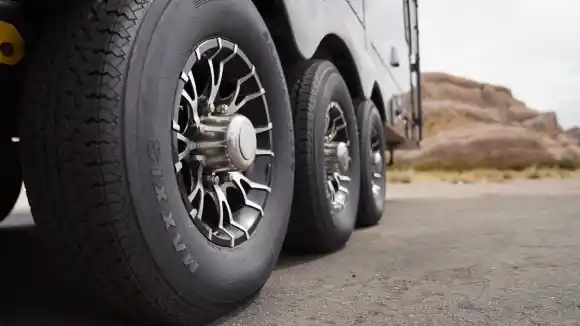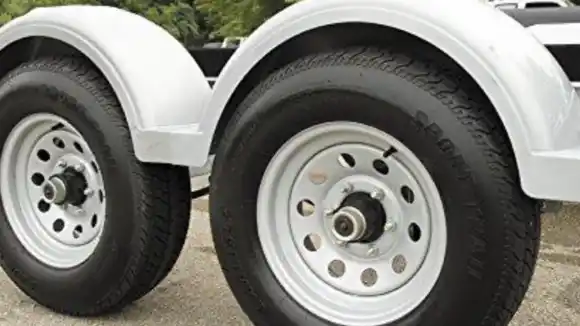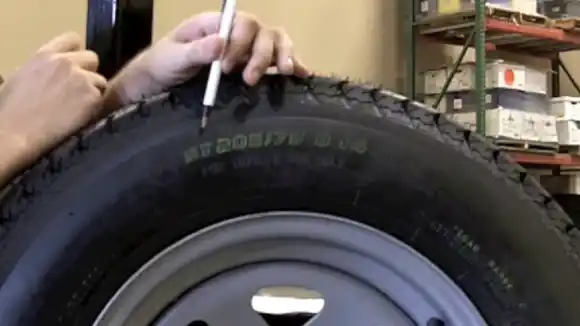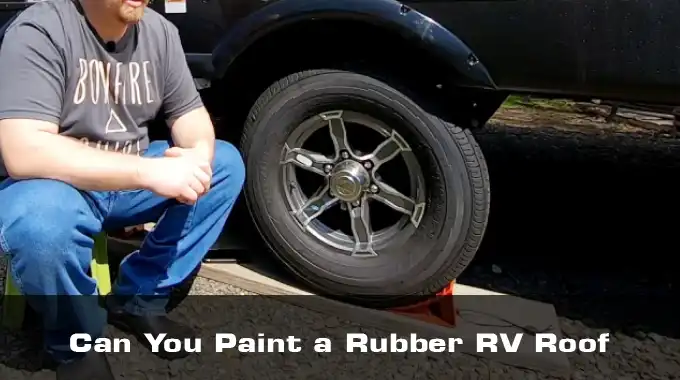Last Updated on July 24, 2023
Towing a trailer involves traveling at a speed that significantly impacts the safety and performance of its trailer tires. As a result, it is necessary to ask what the speed rating of trailer tires is.
Trailer tires do have a speed rating. You will find the trailer tire’s speed rating on the sidewall, in the owner’s manual, on the manufacturer’s website, or at the dealer’s shop. However, understanding the specifics of this rating system can be a bit more complicated.
Throughout this article, we shall examine the speed rating of a trailer tire, its location, and its implications on your towing encounter. Brace yourself as we deep dive into the intriguing universe of trailer tire speed ratings.
Where Can You Find Out a Trailer Tire’s Speed Rating?

There are several reliable sources for finding out the speed rating of trailer tires.
- Sidewall of the Tire
- Owner’s Manual
- Manufacturer’s Website
- Dealer Shop
1. Sidewall of the Tire
The sidewall of a trailer tire typically displays a letter indicating its speed rating, which is an important factor to consider when selecting tires for your trailer. The speed rating is typically indicated by a letter at the end of the tire’s technical description on the sidewall.
The letters G, J, K, or L correspond to different speed ranges, with L being the highest. Selecting a tire that’s right for your trailer is important. If you plan to use your trailer for high-speed travel, you’ll need a tire with a higher speed rating to ensure safe handling and performance.
On the other hand, if you are using your trailer primarily for lower-speed travel, a tire with a lower-speed rating may be sufficient. Check the sidewalls of your trailer tires to see how fast they go, and pick the right tires.
2. Owner’s Manual
Interestingly, the owner’s manual of a vehicle or trailer is a great resource for tire information. The manual often details the recommended tire size, load capacity, and speed rating. These guidelines ensure that the vehicle and trailer are safe and performing at their best.
To illustrate the importance of the speed rating information provided in the owner’s manual, consider the following table:
| Speed Rating | Maximum Speed (mph) | Maximum Speed (km/h) |
| L | 75 | 120 |
| M | 81 | 130 |
| N | 87 | 140 |
| P | 93 | 150 |
| Q | 99 | 160 |
| R | 106 | 170 |
| S | 112 | 180 |
| T | 118 | 190 |
| U | 124 | 200 |
| H | 130 | 210 |
| V | 149 | 240 |
| W | 168 | 270 |
| Y | 186 | 300 |
As shown in the table, each speed rating corresponds to a maximum speed that the tire is designed to handle. Exceeding this speed can lead to overheating and potential tire failure, putting the safety of the driver and passengers at risk.
3. Manufacturer’s Website
By visiting the tire manufacturer’s website and looking at the tire’s technical specs, you can find out what the tire’s maximum speed is. Trailer tires have a speed rating indicated by a letter code ranging from L to Y.
This code indicates the maximum speed that a tire can safely handle based on standardized testing conditions. The speed rating is usually listed in the tire’s specifications or technical details, along with other information such as load capacity, tire size, and construction.
4. Dealer Shop
If you need help identifying the appropriate speed rating and selecting the right trailer tire for your specific needs, consult a professional tire dealer or mechanic. Trailer tires are generally designed for highway speeds, but the speed rating may vary based on the manufacturer and type of tire.
The speed rating is usually indicated on the tire sidewall and is represented by a letter code that corresponds to a maximum speed capability. Choose a trailer tire with a speed rating that fits the type of trailer and the intended use.
A tire dealer or mechanic can help determine the appropriate speed rating based on the trailer’s weight, the type of vehicle towing the trailer, and the typical driving conditions. They can also guide other important factors such as load capacity, tire size, and tread design.
What Are the Consequences of Exceeding a Tire’s Speed Rating?

Exceeding a trailer tire’s speed rating can lead to serious consequences. Some of the most common are:
Increased Heat
Excessive speed causes a tire to generate more heat than it can dissipate, resulting in tire degradation and accelerated wear. The increased heat can also cause the tire’s rubber to become softer, decreasing the tire’s overall performance. This can cause blowouts, less handling, and less stability, especially in critical situations.
To prevent tire degradation and maintain optimal performance, it is crucial to adhere to the tire’s speed rating and not exceed it. In addition, regular tire inspections can help to identify any signs of tire degradation, and replacing the tire on time can help to prevent any safety hazards on the road.
Tire Failure
Tire failure caused by excessive heat can result in dangerous blowouts, compromising the vehicle’s stability and control on the road. When a tire becomes overheated, it can weaken the internal structure, making it more susceptible to punctures, cuts, and other forms of damage.
This can cause the tire to fail unexpectedly, leading to a sudden loss of air pressure and a blowout. Blowouts can be dangerous when you’re driving a trailer because they can cause you to lose control, which can be disastrous. It can sway or jackknife, colliding with other cars, pedestrians, and objects.
Reduced Traction
In the previous subtopic, we discussed the possibility of tire failure when exceeding the speed rating. This failure can lead to compromised vehicle handling and put drivers at risk. Building on this idea, it is important to note that exceeding the speed rating can also reduce the tire’s traction on the road surface.
This can be especially dangerous during braking or cornering maneuvers, as the tire may not be able to grip the road as effectively as it would at a lower speed. Here is a table that shows how speed affects tire traction:
| Speed (mph) | Reduction in Traction (%) |
| 50 | 0 |
| 60 | 10 |
| 70 | 20 |
| 80 | 30 |
Wobbling or Vibrations
When a tire is driven at high speeds beyond its capabilities, its irregular wear pattern and unbalanced state can cause it to wobble or vibrate, creating an unsettling experience. This is particularly true for trailer tires, often subjected to heavy loads and long distances.
The excessive heat generated by driving at high speeds can cause the rubber to break down, leading to cracks and bulges in the tire. These deformities can cause the tire to become unbalanced and produce vibrations as it rotates, creating a potentially dangerous situation for the driver.
It is important to note that these vibrations may only sometimes be noticeable, as they can start out small and gradually increase in intensity. Drivers may mistake them for other issues, such as alignment problems or suspension issues.
The underlying cause of these vibrations must be identified and addressed promptly to prevent further damage. Always follow the tire’s speed rating and keep the trailer from overloading it to avoid these problems.
Safety Risks
Exceeding the recommended speed limit for a vehicle poses a significant danger to all individuals on the road. This is particularly true regarding trailer tires that may not have the same speed rating as the towing vehicle.
If a trailer tire goes over its speed limit, it can compromise tire performance, which increases the risk of accidents, loss of control, and property damage. It is important to note that trailer tires do have speed ratings, and it is essential to follow these ratings to ensure the safety of everyone on the road.
The tires on trailers are typically designed to handle a certain speed limit, and exceeding that limit can cause them to overheat and fail.
Drivers should pay close attention to the speed rating of their trailer tires and ensure they are not towing at speeds exceeding this limit. By doing so, they can help keep themselves and others safe on the road.
What Do the Different Letters Mean on the Tire’s Sidewall?

Understanding the meaning behind each letter on a tire’s sidewall is key to selecting the right tire for your needs. The letters B through V represent the speed range of tires for the average person or RV owner, from 31 to 149 miles per hour. Meanwhile, letters beyond V are for high-performance vehicles or race cars.
A higher speed rating isn’t necessarily better, as tires with higher speed ratings often sacrifice other important factors like tread life and ride comfort. When purchasing trailer tires, it is important to consider the weight and speed rating of the tire.
Due to their nature, trailer tires have a lower speed rating than passenger car tires. Trailer tires are designed to carry heavy loads and maintain stability rather than provide high-speed performance. To ensure safe operation, it’s recommended to choose trailer tires with a speed rating that matches their intended use.
Do trailer tires have a load rating per tire?
One important consideration when selecting trailer tires is the load range, which indicates the maximum weight that an individual tire can carry. Trailer tires are designed to handle different weights, and choosing the right load range is essential to ensure the safety of your boat and trailer.
Generally, the load range runs from the lightest weight a tire can carry, Load Range B, to the heaviest, Load Range E. It is important to note that the load range varies between tire manufacturers, and it is crucial to consult the tire manufacturer’s specifications for specific load capacity.
See the table below for trailer tire load ranges and their corresponding maximum weight capacities.
| Load Range | Maximum Weight Capacity (lbs) |
| B | 1,100 |
| C | 1,520 |
| D | 2,200 |
| E | 2,830 |
| F | 3,750 |
What is the most suitable tire to put on a trailer?
The tire choice for a trailer ultimately depends on factors such as load capacity, durability, and performance at highway speeds. When it comes to load capacity, it is important to choose a tire that can handle the trailer’s weight and its contents.
The load rating per tire can usually be found on the tire’s sidewall and should be matched to the trailer’s weight. Durability is also an important factor to consider, especially for trailers that may be parked for extended periods of time.
Radial tires tend to last longer and are less likely to develop flat spots, making them a good choice for trailers that may be parked over the winter. Performance at highway speeds is another important consideration when choosing a tire for a trailer.
Radial tires perform well at higher speeds, dissipate heat better, and offer lower rolling resistance for a smoother ride. This makes them a good choice for trailers traveling long distances on highways.
What’s the fastest you can go on 13-inch trailer tires?
13-inch trailer wheels/tires the size 185/80-13 have a rated speed limit of up to 81 MPH. Still, it is important to consider the specific load capacity and other factors of the trailer before determining the safest speed to travel.
Going above the speed limit can cause excessive heat buildup, leading to tire failure and potential accidents. Tire manufacturers also recommend checking your tires for wear and damage before every trip and ensuring they’re inflated properly.
To further illustrate the importance of following the speed rating, the table below compares the maximum speed limit for various common trailer tire sizes. Ratings are based on ideal conditions, so drive at a safe, appropriate speed for your trailer.
Is it okay to mix trailer tire speed ratings?
Moving on from the previous subtopic, it is important to understand the significance of matching speed ratings of trailer tires. As mentioned earlier, it is not recommended to mix tire speed ratings on any vehicle. The same applies to trailer tires.
Each tire has a specific speed rating that indicates the maximum speed at which it can safely operate. Therefore, it is crucial to maintain consistency in speed ratings on all trailer tires.
Mixing different speed ratings can lead to various issues, including handling, stability, and safety concerns. A trailer with mismatched speed ratings can cause uneven weight distribution, resulting in a loss of control while driving.
Moreover, traveling at high speeds on a trailer with tires of different speed ratings can cause overheating, tire failure, and other related problems. Therefore, it is essential always to install trailer tires with matching speed ratings and maintain them appropriately to ensure safety and optimal performance.
Keep Your Trailer Safe with Proper Tire Selection and Speed Limits
Trailer safety depends on adhering to proper speed limits and load capacities. It’s a formal matter that ensures drivers’ and their cargo’s safety and security. Choosing the right tire for your trailer is crucial, and the tire’s speed rating is no exception.
Sidewall speed ratings from ‘L’ to ‘Y’ are a helpful tool in ensuring maximum safety while on the road. Exceeding them can bring about disastrous consequences like flat tires, tire failure, and accidents. Furthermore, a tire’s load rating is just as important, indicating the maximum weight a tire can carry.
To steer clear of accidents and tire malfunctions, it is crucial to select the appropriate tire for your trailer. While assessing the speed and load capacity, factoring in the surface type is equally essential. Assess your tires’ speed rating, load capacity, and general condition before a trip to ensure safety.



